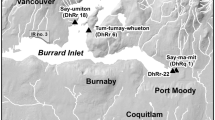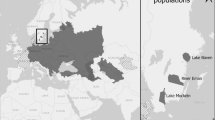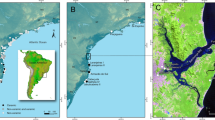Abstract
Despite the growing importance of farmed fish for contemporary economies, the origins of aquaculture are poorly known. Although it is widely assumed that fish domestication began much later than the domestication of land animals, the evidence is largely negative. Here, we use age-mortality and species-selection profiles of fish bones from prehistoric East Asia to show that managed aquaculture of common carp (Cyprinus carpio) was present at the Early Neolithic Jiahu site, Henan Province, China, by around 6000 bc.
This is a preview of subscription content, access via your institution
Access options
Access Nature and 54 other Nature Portfolio journals
Get Nature+, our best-value online-access subscription
$29.99 / 30 days
cancel any time
Subscribe to this journal
Receive 12 digital issues and online access to articles
$119.00 per year
only $9.92 per issue
Buy this article
- Purchase on Springer Link
- Instant access to full article PDF
Prices may be subject to local taxes which are calculated during checkout

Similar content being viewed by others
Data availability
The pharyngeal bone and tooth remains analysed here are curated in the following institutions: Jiahu: Institute of Archaeology, Chinese Academy of Social Sciences, Beijing; Tianluoshan: Zhejiang Provincial Institute of Archaeology, Hangzhou; Asahi: Aichi Prefectural Centre for Archaeological Operations, Yatomi City, Aichi; Irienaiko and Akanoi: Cultural Property Protection Division, Shiga Prefectural Board of Education, Ōtsu City, Shiga.
Change history
24 September 2019
An amendment to this paper has been published and can be accessed via a link at the top of the paper.
References
The State of World Fisheries and Aquaculture 2016 (FAO, 2016).
Bailey, G. N. in The Early Post-glacial Settlement of Northern Europe (ed. Mellars, P.) 37–63 (Duckworth, 1978).
Erlandson, J. M. Anthropocene 4, 24–32 (2013).
Zeder, M. A. in Human Dispersal and Species Movement: From Prehistory to the Present (eds Boivin, N. et al.) 261–303 (Cambridge Univ. Press, 2017).
Nash, C. E. The History of Aquaculture (Wiley-Blackwell, 2011).
Liu, J.-K. & He, B.-W. (eds) Cultivation of the Chinese Fresh Water Fishes 3rd edn (Science Press, 1992) (in Chinese).
Duarte, C. M., Marba, N. & Holmer, M. Science 316, 382–383 (2007).
Balon, E. K. J. Fish. Biol. 65, 1–27 (2004).
Diamond, J. Nature 418, 700–707 (2002).
Teletchea, F. & Fontaine, P. Fish Fish. 15, 181–195 (2014).
Zohar, I., Dayan, T., Goren, M., Nadel, D. & Hershkovitz, I. PLoS ONE 13, e0198747 (2018).
Dinu, A. Doc. Praehist. 37, 299–310 (2010).
Nakajima, T. in Beyond Affluent Foragers: Rethinking Hunter-Gatherer Complexity (eds Grier, C. et al.) 45–53 (Oxbow, 2006).
Fuller, D. Q. & Qin, L. World Archaeol. 41, 88–111 (2009).
Nakajima, T. et al. Int. J. Osteoarchaeol. 22, 294–304 (2012).
Nakajima, T., Nakajima, M. & Yamazaki, T. Int. J. Osteoarchaeol. 20, 127–134 (2010).
Henan Provincial Institute of Archaeology and Cultural Heritage Wuyang Jiahu (Science Press, 1999) (in Chinese).
Zhang, J., Harbottle, G., Wang, C. & Kong, Z. Nature 401, 366–368 (1999).
Li, X., Harbottle, G., Zhang, J. & Wang, J. C. Antiquity 77, 31–44 (2003).
Cucchi, T., Hulme-Beaman, A., Yuan, J. & Dobney, K. J. Archaeol. Sci. 38, 11–22 (2011).
Nakajima, T. et al. Quat. Sci. 35, 192–198 (2015) (in Chinese).
Zhang, J. in Environmental Archaeology (eds Pişkin, E. et al.) 199–227 (Springer, 2018).
Nakamura, M. Cyprinid Fishes of Japan: Studies on the Life History of Cyprinid Fishes of Japan (Research Institute Natural Resources, 1969) (in Japanese).
Brett, J. R. in Bioenergetics and Growth, Fish Physiology Vol. 8 (eds Hoar, W. S. et al.) 599–675 (Academic Press, 1979).
Lafon, X. J. Rom. Archaeol. 11, 573–582 (1998).
Marzano, A. Harvesting the Sea: The Exploitation of Marine Resources in the Roman Mediterranean (Oxford Univ. Press, 2013).
Nakajima, T., Nakajima, M., Uchiyama, J. & Seguchi, S. in Irie Naiko Iseki (ed. Shiga Prefecture Board of Education and Shiga Institute of Cultural Heritage Protection) 148–162 (Shiga Prefecture, 2008) (in Japanese).
Acknowledgements
We thank J. Yuan for permission to examine pharyngeal remains from Jiahu, Z. Li and P. Lü for photographs of the pharyngeal teeth, Ō. Nishizawa and Matsukawa Village office for permission to measure carp from Matsukawa, and Y. Fujioka for advice concerning carp aquaculture. The research leading to these results has received funding from JSPS KAKENHI Grants (nos. 22401002 and 26300004), the NEOMAP project of the Research Institute for Humanity and Nature (no. H-04), the European Research Council under the European Union’s Horizon 2020 research and innovation programme (grant no. 646612), the Sainsbury Institute for the Study of Japanese Arts and Cultures (7th Handa Japanese Archaeology Fellowship under the International Jomon Culture Conference), National Basic Research Program of China (grant no. 2015CB53802) and National Natural Science Foundation of China (grant no. 41472148).
Author information
Authors and Affiliations
Contributions
T.N. conceived the initial study and conducted analyses of fish remains from Jiahu with critical input from K.M. and J.Z. M.J.H. and J.U. conducted the fieldwork at Matsukawa. All authors interpreted the results and implications. T.N. and M.J.H. wrote the manuscript with input from J.U. who prepared the figures.
Corresponding author
Ethics declarations
Competing interests
The authors declare no competing interests.
Additional information
Publisher’s note Springer Nature remains neutral with regard to jurisdictional claims in published maps and institutional affiliations.
Supplementary information
Supplementary Information
Supplementary Figs. 1–4 and Tables 1 and 2.
Rights and permissions
About this article
Cite this article
Nakajima, T., Hudson, M.J., Uchiyama, J. et al. Common carp aquaculture in Neolithic China dates back 8,000 years. Nat Ecol Evol 3, 1415–1418 (2019). https://doi.org/10.1038/s41559-019-0974-3
Received:
Accepted:
Published:
Issue Date:
DOI: https://doi.org/10.1038/s41559-019-0974-3
This article is cited by
-
Asymmetric and parallel subgenome selection co-shape common carp domestication
BMC Biology (2024)
-
Aquaculture in the Ancient World: Ecosystem Engineering, Domesticated Landscapes, and the First Blue Revolution
Journal of Archaeological Research (2023)
-
Bacterial communities in co-cultured fish intestines and rice field soil irrigated with aquaculture wastewater
AMB Express (2022)
-
Integrated pond aquaculture and regional identity: ethnobiology of the golden humped tench of Poirino highlands, Northwest Italy
Journal of Ethnobiology and Ethnomedicine (2022)
-
Listening with the invasive fish ear: applications and innovations of otolith chemistry analysis in invasive fish biology
Environmental Biology of Fishes (2022)



